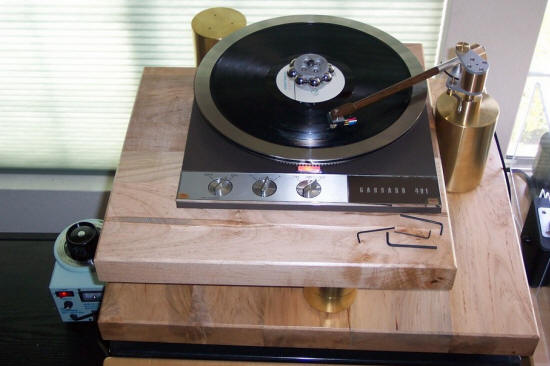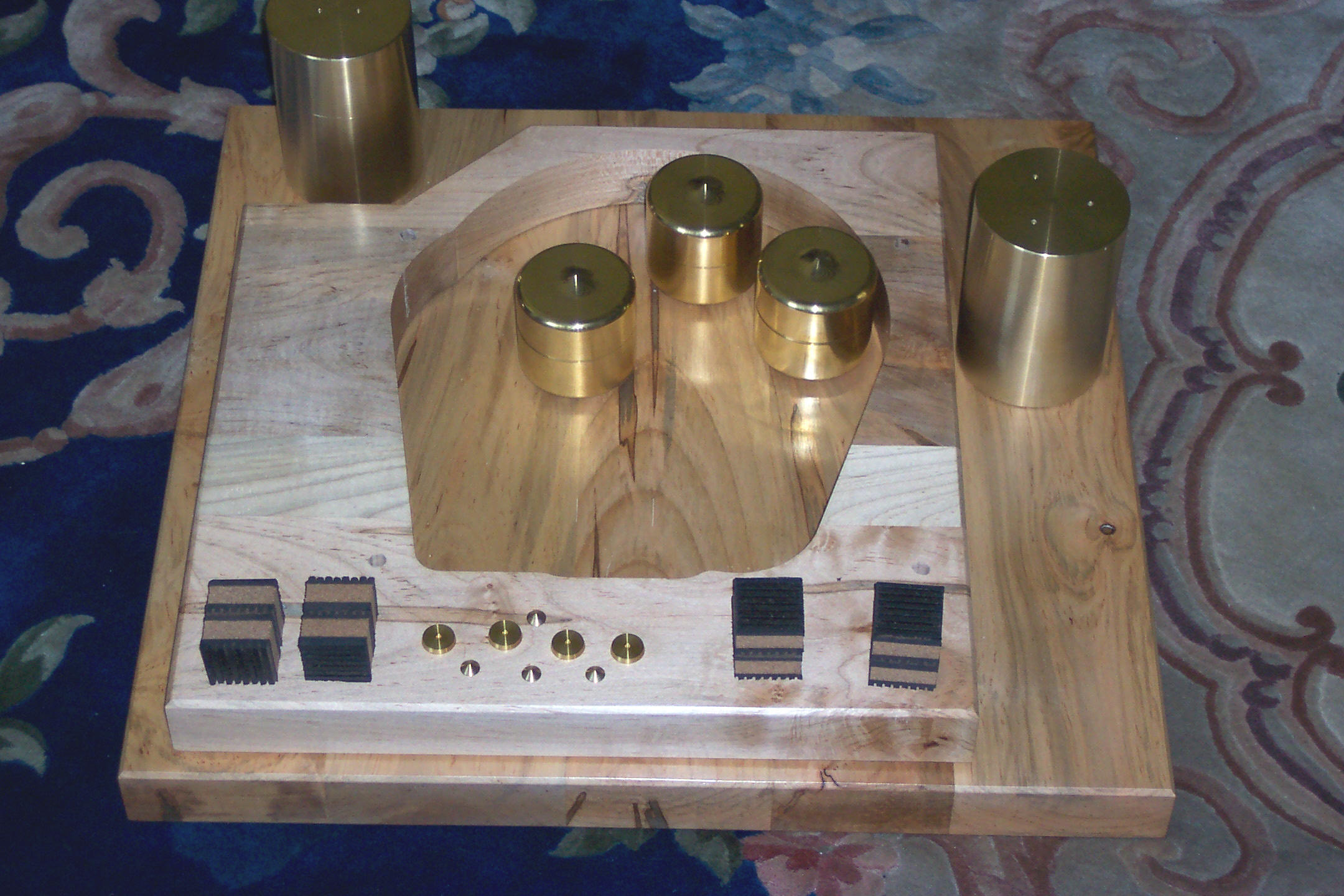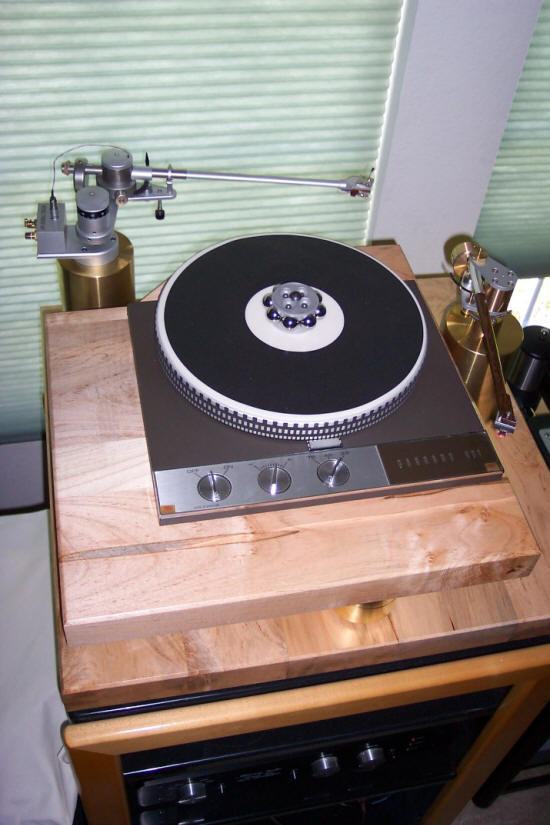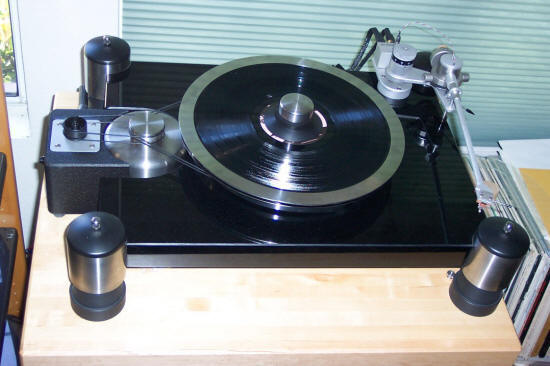|
You are reading the older HTML site
Positive Feedback
ISSUE
25
The
Search for Music (Continues) - Garrard 401 Turntable
Over the last couple of years, there has been quite a buzz in the various online audio forums regarding idler-wheel/rim drive turntables (Garrard 301/401, Lenco, Russco, Rek-O-Cut, etc.). The "Building high-end 'tables cheap at Home Despot" thread on Audiogon, which has 3394 replies and still going strong, is one example. The most famous of the idler-wheel turntables, the Garrard 301, in its earliest grease bearing guise, has even attained cult status in Japan. A fully tricked out Shindo grease bearing 301 with vintage arm and cartridge retails for almost US $20,000. What is it about idler-wheel turntables—turntables that have not been made since the '70s, or earlier—that gets people so excited? Jeff Day’s September 2004 article in www.6moons.com about buying a used Garrard 301 off of e-bay and getting it to play enjoyable music without too much effort was one of the mostly highly read articles at 6moons. Jeff wrote a follow-up article in May 2005 wherein he described how he remounted his 301 on a skeletal plinth designed and made for him by Terry Cain of Cain & Cain speakers. The resultant plinth looked striking and Jeff thought the sound was wonderful. Jeff’s two articles, plus others that I read online about resurrecting Garrard 301 and 401 turntables, all said that when setup properly the idler-wheel Garrards played music. As a music-lover, I am always looking for ways to bring the concert hall experience into my listening room. After looking carefully at the design of the Cain skeletal plinth I decided that even with my limited mechanical skills (and the help of a good friend with a machine shop), I could make something similar. So onto e-bay I went looking for a Garrard 401. I had decided on the later model 401 rather than the more highly sought after 301 for two reasons. One was price—Garrard 301s cost significantly more than 401s since the grease bearing 301s have cult status. The second reason related to several comments regarding 401s on the Loricraft website (www.garrard501.com). The people at Loricraft, of record cleaning machine fame, are also the bearers of the Garrard torch. They bought the use of the Garrard name. They restore 301 and 401 Garrards, make and sell enclosed and skeletal plinths and variable power supplies for 301s and 401s, and have designed and currently manufacture the Garrard 501 idler-wheel turntable. With these impeccable credentials, I took to heart their comments that the 401 turntables were better designed than the 301, though not as well manufactured. That is, the 401 motor was a better motor than the 301 motor, and that the oil bearing of the later 301s and all 401s was designed for stereo LPs, while the grease bearing had been designed for mono LPs. They did not explain why stereo required a difference bearing. However, the Loricraft statements, plus the lower price, convinced me to seek a 401. A few days after I first started looking for a 401 on e-bay I found a listing for a late model 401 that was unused. It was not sealed in the original box, but the seller said it had never been used. I bid on the auction and lost. However, the winning bidder never contacted the seller. Thus, I won the unused 401 by default. When the 401 arrived, I opened the box with trepidation. Had I bought a pig-in-the-poke? No, for US$1200 I had bought a Garrard 401 in perfect condition. It had never been used and was still mounted on the original shipping plinth. The protective clear plastic film was still covering the nameplate and the shiny metal center of the rubber mat. When I dismantled the spindle bearing to re-oil it, I found the felt washer that serves as an oil reservoir for the bearing to be bone dry. But the bearing itself was still covered in clean oil and the bearing and spindle shaft had no wear marks on them. Likewise, when I opened the motor unit to re-oil the bottom bronze bearing, which was bone dry, there were no wear marks inside the motor. So I really had a brand new 401. Amazing. Now I only needed a plinth to which mount it. As I sat down to design a simple skeletal plinth, I had several goals in mind. First, the plinth needed as many off-the-shelf parts as possible. I did not have the tools or the skill to make parts myself and I could not burden my friend with the machine shop with too many demands for exotic parts. I also am of the belief that vibrations are reflected back from boundaries with dissimilar materials. Thus, the number of boundaries that vibrations have to pass through to reach the bottom board (vibration sink) should be as few as possible. Also, I wanted a turntable that could accommodate three tonearms at a time and make swapping additional tonearms in and out as simple as possible. Once I had the design on paper, I contacted several of the online woodworkers that make maple butcher-block bases for audio equipment. I sent them dimensions and asked for quotes for 2 inch thick maple bases made from maple boards instead of the vertical slats that are used in butcher-block—the fewer boundaries theory again. Thus, the top plinth is made from only three boards instead of nineteen 1" slats. The three large brass cones (Megafooters), the four brass mini-points, and the four Isolators (rubber and cork isolation devices) are off-the-shelf items from Mapleshade Record (www.mapleshaderecords.com). (The four brass disks shown in the photo, on which the mini points were going to rest, were ultimately not used. The sound was better with the brass mini points under each corner resting directly on the maple plinth.) The only things missing now were the brass pods for mounting the tonearms and cutting the center out of the plinth so that the 401 motor unit could be dropped in. After discussions with my machinist friend, we arranged a day when we could spend the afternoon making the parts. I gave him a copy of the plinth-mounting diagram from the 401 owner’s manual so that he could program his CNC mill ahead of time. He also promised to stop by a metal supply house to find some brass for the tonearm pods.
On the appointed afternoon, I showed up at his shop with the two maple bases, my 401, and tonearm bases and matching bolts for my VPI 12.5 and Schroeder Reference tonearms. Machining the center out of the plinth was no problem with the CNC mill. However, the bolts supplied with the 401 were too short to go all the way through the 2-inch maple plinth. My friend took some brass rod and made longer bolts; one end being English standard to thread into the four threaded holes at the corners of the 401's metal frame, with American standard on the other end for convenience. The holes drilled through the plinth for the four bolts were initially drilled only slightly larger than the bolts themselves. We made the assumption, incorrect as it turned out, that the four threaded mounting holes in the 401's metal frame were perpendicular to the surface of the turntable. Not so. If you are only using a plinth of less than ½-inch thickness, you probably won’t have a problem. However, when going through two inches of plinth, even a degree or two away from perpendicular causes the mounting bolts to bind. So the moral is, if you are using a thick plinth, drill your bolt holes larger than normal. (Was the degree or two off true vertical an example of the 'lack of execution’ mentioned on the Loricraft website?)
With the plinth finished, it was time to turn to the brass tonearm pods. My friend had found a solid column of brass (3.5 inches in diameter x four feet long) in the remnant bin at a metal supply house. Two five-inch sections were sawed off. The sections were put into a lathe to have the ends trued and a little taken off the sides to get a clean finish. Back to the CNC mill to drill the mounting holes, tap by hand, and after only 4 hours, everything was done. Back home I cut the female end off an old two-wire extension cord, stripped back the insulation and attached the cord to the power terminal block on the underside of the turntable. Everything was now ready. After all this effort, would it work? And even if it did work, would the quality of the sound justify the time and effort? I assembled the various parts, leveled the table via the threaded points under the top shelf of the Polycrystal rack, mounted the Schroeder Reference on its pod, mounted a Van den Hul Condor XGM on the Schroeder and aligned it. The moment of truth had arrived. I turned it on. The strobe light came on. The platter spun. I adjusted the eddy brake to get the speed to exactly 33 1/3rd rpm, put on a clean, but expendable LP and place the stylus in the lead-in groove. Music! Glorious Music! It took me a while to get the magnetic damping on the Schroeder just right—this was the first time I had used my new Schroeder. And I had to adjust azimuth as well.
Once I was satisfied with the arm and cartridge, I plugged the Garrard into a $40 variac that I had purchased off e-bay. Like many turntable motors, the Garrard motor runs with less vibration at less than maximum voltage. My mains voltage is 117v. With the variac, I found that I could drop the voltage to 104v without losing speed. Below 104v, the speed drop could be compensated for by adjusting the eddy brake. Below 92v, the sound quality disappeared. With a little experimentation, I found that 100-102v seemed to give the best sonics. I also experimented with a Herbies Audio Lab Grunge-Buster Vintage Ultra-thick Turntable Mat. I thought it was quieter than the original Garrard rubber mat. A Van Slyke Engineering Record weight (www.vsengr.com/orbitals.html) was added because I needed a weight if I was going to use my Universal Record Stabilizing Ring (reviewed in Positive Feedback Online Issue 20 www.positive‑feedback.com/Issue20/ursrclamp.htm). I could have machined a weight from brass or aluminum, but I have always thought the VSE Orbitals looked cool. With everything running smoothly, I sat back and listened to music for a few days. I figured the new tonearm, new tonearm cables, new turntable, and cartridge just back from its 300-hour factory tune-up could use a few days of burn-in. This was not an arduous task. I was really enjoying the music. After a few days of listening, I could not stand it any longer. I had to compare the Garrard with my VPI TNT-5. My TNT has been upgraded with the new 300-rpm motor with flywheel and I always use the URSR periphery ring. Both have made a noticeable improvement to the stock TNT-5. For the comparison between the two tables, I selected five LPs that I know very well in my system: Jennifer Warnes: Famous Blue Raincoat, First We Take Manhattan (Cypress 661 111-1) Nirvana, Unplugged in New York, About a Girl (Geffen DGC 24727) Pete Townshend, Secret Policeman’s Ball, Pinball Wizard (Island WIP 6598) Louis Armstrong, Satchmo Plays King Oliver, St. James Infirmary, Classic Records 45rpm reissue Brucker, Symphony No. 9, 1st Movement, EMI ASD 493 (Speakers Corner reissue) I played these five tracks on the TNT using my 12.5 tonearm and ZYX UNIverse-S SB cartridge. I then moved the 12.5 arm and cartridge to the Garrard. Everything else stayed the same—electronics, cabling, everything. After adjusting VTA, I then replayed the five tracks. On the Garrard, the tone and timbre of the recordings were the same. So was the level of detail being extracted from the grooves. What was different were three things. First, the soundstage was bigger, wider, and deeper by about 20%. However, the boundaries of the soundstage were not as clearly delineated on the Garrard. On the TNT, the soundstage had clear borders—music was on this side, no music on that side. With the Garrard, you knew the general limits of the soundstage, but the borders were not clear. You could not point to a place in space and say that was where the soundstage ended. The second difference is that on the Garrard, the music was more up front. It was as if you had moved three rows closer to the stage. The third difference is the BIG ONE—the one that everyone talks about when they talk about idler-wheel turntables—musicality. There is a life, an animation to the sound, which is just more involving. The music just sounds more like live music. While I was doing this comparison, I received a call from a friend. He had a Dynavector XV-1s cartridge home on approval. He had compared it to his own cartridges and wanted to compare it to my UNIverse and Van den Hul XPW Colibri. I said come on over. He brought the Dynavector mounted on a VPI 12.5 armwand. While he was coming over, I moved the 12.5 arm back to the TNT. When he arrived, we aligned the XV-1s cartridge and adjusted VTA. We then matched sound levels using a sound pressure meter between his Dynavector, and my ZYX UNIverse and Colibri, all mounted on 12.5 armwands. We spent several hours doing the A-B, A-C, B-C comparisons. Once we thought we had the differences between the three cartridges sorted out I suggested that we listen to the Garrard 401 with the Schroeder arm and Condor cartridge. I put the same test record that we had been listening to for several hours on the Garrard. As soon as the first few notes came out of the Garrard, my friend started to laugh. He said that there was no comparison. The Garrard/Schroeder/Condor combo sounded so much better than the three more expensive cartridges sounded on the TNT. I said the Schroeder arm is a better arm than the VPI 12.5. That could be the difference. My friend said that the TNT-5 plus 12.5 arm cost more than the Garrard 401 plus Schroeder arm. At that point, we stopped talking and just started to spin vinyl. The next day I went back to doing the comparison between the TNT and the Garrard via moving the 12.5 arm back and forth between the two turntables. This time I was using the Colibri cartridge. Based on the comparisons it was obvious to me that the VPI 12.5 arm sounded better on the Garrard than it did on the TNT, a turntable for which it has been optimized. Hmmm. Over the next two weeks, I continued to tweak the 401. When holding the headshell of the VPI 12.5 arm lightly between two fingers while the arm was suspended in the air I could feel a small vibration when the motor was running. With that clue, I tried the same with the Schroeder arm. No vibration in the armwand—no great surprise there as the Schroeder armwand is made of wood and is suspended from the tone arm column by a piece of string. However, there was a small vibration in the tonearm column itself. I had some Herbies Audio Lab grunge-buster washers (3/4" OD and 1/4" ID) on hand. Putting these washers under the brass tonearm pods and between the top of the brass tonearm pods and the base of the tonearms themselves reduced the vibrations. Knowing I was on the right track I ordered two sheets of Herbies Audio Lab grunge-buster gasket material in 5" x 8" sheets. From these sheets, I cut out two 3.25" diameter circles—one each to go under both of the brass tonearm pods. Using the bases of each of the tonearms as a pattern, I also cut out pieces of grunge-buster material that matched the footprint of each of the tonearm bases. With the grunge-buster material installed between the bottom maple board and the bottom of the tonearm pods and between the top of the tonearm pods and the bottom of the tonearms columns, the vibration was reduced completely in the Schroeder arm and significantly in the VPI arm. I then added a second layer of grunge-buster material to the top and bottom of the VPI arm pod. The vibration was now gone. The grunge-buster material is very firm and even two layers of 1.6mm material (3.2mm total) under the VPI arm pod did not cause the pod to wobble in the slightest. In addition to these tweaks to the tonearm pods, I used Herbies Audio Lab Tenderfoot dampers under the spindle bearing and under the motor to damp additional vibration. Both the spindle bearing and the motor unit drop down from the metal chassis. Thus, it is easy to place dampers or feet under both. By changing how hard the Tenderfoot is pressed against the bottom of the spindle bearing (by adding or subtracting shims), you can change the resonant frequency as well as the amount of damping. So some experimentation is necessary to find the correct pressure. Unlike the spindle bearing which is bolted to the chassis, the motor unit is suspended on springs. As you add more shims under the Tenderfoot that is under the motor unit, you are relieving the tension on the motor mount springs. I need further experimentation to decide what the correct tension for the springs is. A number of Garrard experts actually recommend removing the motor mount springs entirely and supporting the motor unit completely from below. Something to try in the future.
After making these changes, the Garrard was sounding very good. To my ears, it now sounded significantly better than my VPI TNT-5. To make sure that I was not deluding myself I invited two audio friends over. One of these friends does not own a turntable. Neither of them knew anything about the recent resurgence in interest in idler-wheel technology. They thought idler-wheels were some ancient technology that was replaced by the better sounding belt drive turntables. When they arrived, I had the VPI arm with the Colibri cartridge mounted on the TNT. I played for them the same five cuts that I had played for my other friend two weeks prior. The VPI arm was then moved to the 401 and the same five cuts were played again. Everything else was kept the same. The turntables were the only variable. As soon as Jennifer Warnes started singing on the first track of the first LP, one of my friends burst out "That can’t be the turntable. What else did you change?" My other friend chimed in "That’s a big change." We played the five cuts and discussed the differences that they were hearing between the two turntables. Their comments boiled down to the 401 being more dynamic. Leading transients were not being rolled off. More slam in the bass. More presence—it was more like the performers were there in the room with you. What they were hearing was hard for them to express exactly. However, they knew it was a big change and that they really liked the change. I have to agree with them.
So I was not being delusional. The Garrard 401 does sound better than the VPI TNT-5. Lets see, the VPI TNT-5 without the 12.5 arm originally sold for $6000. The upgraded motor/flywheel was an additional $900. The Garrard cost $1200, plus $1500 for the maple bases, brass feet, tonearm pod brass, Herbies Audio Lab mat, Tenderfeet, and grunge-buster material, VSE Orbital, variac, etc. I still need to get an external power supply for the 401 like the VPI SDS that came with the TNT-5, but one that will allow me to lower voltage in small steps and raise frequency in even smaller steps. Supposedly, Garrard motor units have the least vibration when voltage is about 100v (assuming 117v mains voltage, with the eddy brake full on and the mains frequency increased by approximately 10% to bring the speed back up to normal). Several different plans for building an external power supply for Garrard motors are available on the web. However, since I don’t have the skills to build one myself, I will probably buy one for $700 - $1000 (a used PS Audio P300 Power Plant with multiwave II+ fits the bill exactly). If I add the cost of the power supply and fair market value of the machining time of my friend, the cost of the Garrard is not that much cheaper than the VPI TNT-5. Obviously, a person with adequate skills and the proper tools could duplicate what I did for significantly less money. However, I have proven to myself that it is possible to take a decades old idler-wheel turntable, resurrect it, and make it sound competitive with one of the finer turntables currently being made. Dang. When I started this project, I was hoping to end up with a second turntable that would be good enough to be part of the dedicated mono system that I was putting together. Instead, I have ended up with a new primary table. Who would have thought that a 35 year old idler-wheel turntable could not only run with pack, but could best one of the previous top dogs? Hmmmm. If ancient technology like idler-wheels sounds so good, I wonder what a direct drive turntable from the early '80s might sound like. I guess there is only one way to find out.
|






